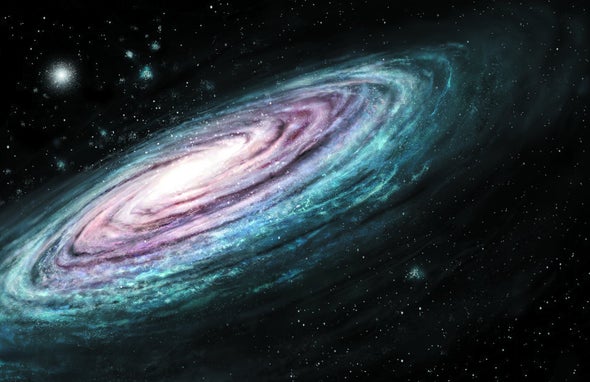
A New Map Of The Milky Way
High-resolution surveys chart the spiral structure of the galaxy and the location of our solar system
- Astronomers know surprisingly little about the structure of our Milky Way galaxy, including the number of spiral arms it has and the location of our sun within it.
- Recently, though, scientists have pieced together the best map yet of our galaxy by using data from several new research projects, particularly the Bar and Spiral Structure Legacy (BeSSeL) radio survey.
- The map reveals at least four major spiral arms in the Milky Way, as well as some smaller features, and shows that the sun lies almost exactly on the central plane of the disk of the galaxy.
Hundreds of years ago explorers sailed across oceans and traversed uncharted continents to map Earth, and in the past half a century space probes have photographed most of our solar system. Yet as well as we have come to know our astronomical backyard, our image of the larger neighborhood—our Milky Way galaxy—is blurry. The reason is obvious: we cannot get outside it to take a peek. Imagine sending a spacecraft on a multimillion-year journey to go beyond our galaxy, look back and snap a picture: clearly impractical. We are left with many open questions about our cosmic home, such as how many spiral arms the galaxy has, whether the large structure closest to the sun counts as an arm and where in the galaxy our solar system lies.
Recent efforts, however, have begun to map the Milky Way from the inside out, allowing us to assemble an accurate snapshot of its structure for the first time. This emerging vista is the result of several large projects involving advanced radio and optical telescopes, including our program, the Bar and Spiral Structure Legacy (BeSSeL) Survey. For this effort, we were granted an unprecedented amount of observing time—5,000 hours—on the Very Long Baseline Array, a system operated by the National Radio Astronomy Observatory and funded by the National Science Foundation./.../
AUTHORS
Mark J. Reid is a senior radio astronomer at the Smithsonian Astrophysical Observatory at the Center for Astrophysics | Harvard & Smithsonian. He was recently elected to the U.S. National Academy of Sciences. Credit: Nick Higgins
Xing-Wu Zheng is a professor of astronomy at Nanjing University in China. He has studied astronomical masers and star formation for decades. Credit: Nick Higgins


No comments:
Post a Comment